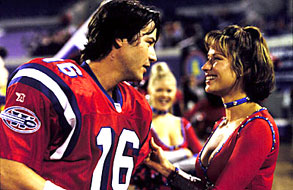You’ve probably seen or heard of it before: the ginormous, ignoramus, jerk of a football player. I cannot count the number of times that High School football players are depicted in those coming-of-age football movies as those 240 pounds of flesh I’ve just described. Unfortunately for the screenwriters, their screenplays are far from the truth. As a former high school football player myself, allow me to acknowledge stereotypes that I’ve noticed that perhaps some other athletes will find relatable.
Let me begin by saying that I am referring more to instances in which football players are not the focal point of the movie. You know, the scenes where some guy with wavy hair in a Letterman jacket is shoving a much smaller kid into a locker because the stereotype is that that’s what football players do. It’s hardly ever the baseball players or the basketball players. It’s almost always a football player who gets the infamous reputation.
The Size

First off, football players are not nearly as large as they are portrayed in movies. One of the reasons for this is that directors cast actors whom are much older than 17 year old teenagers. Another reason for this inaccurate portrayal is that people are lazy. They’re lazy in the sense that they saw one huge football player and assumed that they all work hard to be that size. In reality, skill positions (running backs, wide receivers, tight ends, ect.) work hard to not be super large or overweight. If a wide receiver is 240 pounds, he is probably not going to be able to run a very fast time in the 40 yard dash.
I can tell you that my High School football team was undersized compared to these players that movies depict.
While working out to gain muscle may be a confidence booster, it often comes from a place of insecurity. Body image issues run amok in men too. Society is a major component to this problem and how athletes feel about their bodies.
Secondly, why are football players usually the villain or the antagonist? They’re given a stereotypical name (like Brad) and are shown shoving kids into lockers, beating up smaller kids, and acting like bigots. Football players are just like the theater kids or the glee club in that their entire lives do not revolve around what they are seemingly known for. Many football players play instruments, engage in volunteer work, and go out for movies. Football is one aspect of their life and one aspect only.
The Cheerleaders

Shifting to the topic of cheerleaders, it’s much more rare for football players to date cheerleaders like they seem to do in so many stories. High school students are the type to view something like that as awkward. Don’t get me wrong, it happens. But again, it’s a small percentage of players who actually date cheerleaders and not other kinds of girls with other hobbies.
Selfish Motives
Football players are far from the jerks you see on screen. Yes, they are empathetic, caring people. No, not all are illiterate, uneducated airheads who go looking for fights after school. That’s maybe 3% of players on a team, if that.
In fact, empathy is the core of what team sports are all about. Players understand each others opinions on how to be a successful team. You learn how to battle through hardships. In the process, you gain valuable insight into what goes on in the lives of players outside the gridiron. Players begin to open up to each other. All of this happens because teammates are willing to approach each other and foster trust and communication.
Thus, relationships are strengthened through sports.
The Brains

They say football is 80% mental and 40% physical. Makes sense. Football players don’t just get concussed and hit the guts out of each other. It takes a smart quarterback to read defenses and demonstrate pocket awareness. Running backs need to have terrific open field vision to find the hole to pick apart a defense. It takes brains to be self-aware as a receiver and to know how many steps to take for each pattern. Linebackers are actually all about communicating and getting people lined up correctly before the play starts. They must be fast thinkers who can read the play before it happens. Kickers and punters need to factor in wind resistance when they kick the ball.
I could go on about the mental aspect of football and how much it’s neglected in movies.
Are a few football player like the ones we see in films? Absolutely. But the vast majority are much more likeable people at the high school level. I’m still waiting for the movie about an average-sized kid who plays football and is a non-selfish gentleman. Maybe that’s not too interesting, but it’s more accurate and a fresher take on high school football players.